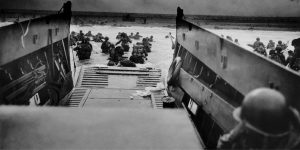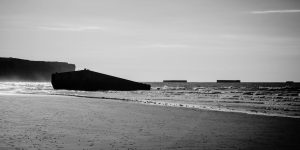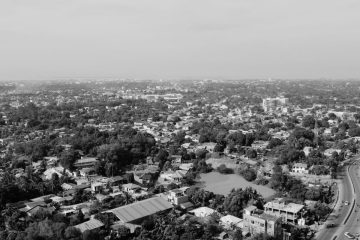What Happened On June 6th?
On June 6, 1944, known as D-Day, 160,000 Allied soldiers stormed the shores of Normandy, France.
In a courageous effort to liberate Western Europe from Nazi occupation, this was the most important military operation in history. Through immense sacrifice and strategic brilliance, the allied forces made a big step in the eventual defeat of Hitler’s forces.
Meticulous Planning
Operation Overlord, the codename for the Allied invasion, took months to plan. Supreme Commander General Dwight D. Eisenhower led the intricate coordination of forces from the United States, United Kingdom, Canada, and other Allied nations. The goal was clear: to establish a foothold in Normandy and begin the liberation of occupied Europe.
The planning process involved deceiving the Germans about the actual landing site. Through Operation Fortitude, the Allies created a phantom army, complete with inflatable tanks and fake radio traffic, suggesting that the invasion would occur at Pas de Calais, the narrowest point between Britain and France. This elaborate ruse successfully diverted German defenses away from Normandy, setting the stage for the real attack.
Night Operations
As dawn approached on June 6th, Allied paratroopers and glider troops had already begun their descent behind enemy lines. Their mission was to secure key bridges and roadways, preventing German reinforcements from reaching the beaches. The night sky was filled with the hum of aircraft engines as over 13,000 paratroopers from the American 82nd and 101st Airborne Divisions, alongside their British and Canadian counterparts, leaped into the unknown.
Their landing zones, scattered and chaotic, led to fierce skirmishes in the dark. Many soldiers found themselves far from their intended drop zones, but they remain calm. They formed ad-hoc units and pressed on with their missions.

Omaha Beach Struggle
As the first light of day broke over the English Channel, the largest amphibious assault in history commenced. The invasion force, consisting of 5,000 ships and landing craft, began its perilous journey across the choppy waters towards the Normandy coast. The beaches were divided into five sectors: Utah, Omaha, Gold, Juno, and Sword, each assigned to different Allied units.
The American forces faced their sternest test at Omaha Beach, where they encountered heavily fortified German defenses. As soon as the landing craft ramps dropped, soldiers were met with a hail of machine-gun fire, artillery shells, and obstacles strewn across the sand. The first waves suffered devastating casualties, but through sheer determination and relentless courage, they inched their way forward, securing a tenuous foothold on the beach.
Further to the west, at Utah Beach, the landing went more smoothly. The 4th Infantry Division, having drifted south of their intended landing zone, found themselves in a less fortified area. This accidental mistake allowed them to advance more rapidly, achieving their objectives with fewer losses. Interestingly, one of the first American soldiers to step ashore, Brigadier General Theodore Roosevelt Jr., led his men with a cane due to his arthritis, displaying remarkable bravery.
British & Canadian Valor
The British and Canadian troops, landing at Gold, Juno, and Sword beaches, faced their own fierce battles. At Gold Beach, the British 50th Infantry Division confronted strong German positions, but with the support of specialized tanks and naval bombardment, they made progress inland. Juno Beach saw the Canadian 3rd Infantry Division battle through heavy resistance, eventually linking up with the British forces at Gold.
Sword Beach, assigned to the British 3rd Infantry Division, was necessary for the capture of the city of Caen. Despite encountering formidable opposition, they pushed forward, bolstered by paratroopers from the 6th Airborne Division who had secured key bridges and neutralized enemy artillery.

Piper Bill Millin, a personal piper to Lord Lovat, played the bagpipes while marching along Sword Beach, defying enemy fire to boost the morale of his fellow soldiers.
Heavy Casualties
By the end of that harrowing day, the Allies had secured a precarious beachhead. The cost of this victory was staggering. Estimates suggest that more than 4,000 Allied soldiers were killed, with thousands more wounded or missing. The German defenders, however, suffered a high a number casualties, with around 4,000 to 9,000 men killed.
The beaches of Normandy were strewn with the wrecked ships, destroyed tanks, and the bodies of fallen soldiers. Yet, amidst this carnage, the bravery and resilience of the Allied forces shone through. They had achieved what many thought impossible, breaking through Hitler’s Atlantic Wall and establishing a critical front in Western Europe. The Allies used portable harbors, known as Mulberry harbors, to facilitate the rapid offloading of cargo and troops, significantly aiding the invasion’s success.
Strategic Success
The successful landings allowed the Allies to pour reinforcements into Normandy, steadily expanding their foothold and pushing inland. The battle for Normandy would rage on for weeks, characterized by brutal fighting in the hedgerows and villages of the French countryside. But the breach had been made, and the path to liberation was now open.
The impact of D-Day resonated far beyond the beaches of Normandy. It bolstered the morale of the Allied nations and sent a clear message to the Axis powers: the tide of war had turned.
The invasion allowed for the eventual liberation of Paris in August 1944 and the subsequent push into Germany, leading to the unconditional surrender of Nazi forces in May 1945.





